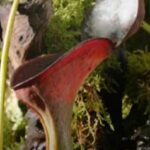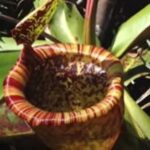As an Amazon Associate, this site earns commissions from qualifying purchases. For more details, click here.
Pitcher plants are beautiful to look at, whether indoors or in your garden, in a pot or hanging on a basket. One thing that prospective buyers may wonder though is, do pitcher plants smell bad? Or do they have a pleasant scent like other plants and flowers? The answers to this questions and more are covered here.
Pitcher plants have an aromatic scent similar to mint, which comes from the nectar they produce to lure insects. These plants however, can smell bad if it is sick or a large bug is rotting inside its pitcher.
Do Pitcher Plants Smell the Same?
Most pitcher plants have a minty odor, but some species have unique fragrances. The odor can come from the nectar they produce or the flowers. Sometimes the leaves and flowers have different smells. Here are examples:
- Flowers from the yellow pitcher plant (oreophila) smell like the Easter Lily.
- Sarracenia flava smells like lavender. However some variants have a more unpleasant scent.
- Sarracenia rubra has a fruity smell. Some people say it is similar to a cherry flavored fruit drink.
- Ultricularia alpnia smells like citrus.
- The sarracenia purpurea smells nice, both its pitchers and flowers.
- Sarracenia leucophylia has a smoky, minty odor similar to some nepenthes plants.
- Flowers from nepenthes have a very distinct, pleasant scent used to entice prey. The smell is very evident when several flowers have bloomed.
- Nepenthes grown in a warm environment with sufficient humidity will produce a lot of nice smelling flowers.
Some nepenthes pitchers have a sweeter smell than their flowers. This is one reason why animals and even people drink from it (after being thoroughly cleaned). This is understandable because the pitcher is used to entice insects and other prey. The smell of the flowers also varies widely.
Keep in mind too that people react to smells differently. What may be a nice scent to you could be unpleasant to others. For example, the smell of S. flava has been compared to lavender by many, yet some find it smells horrible.
Pitcher plant smells are heavily influenced by their feeding habit. A healthy, well fed nepenthes smells nice. If your pitcher plant gets fed with BNYEE Freeze Dried Bloodworms it will produce a good smell as the plant is healthy. But if it is sick, the leaves and flowers will start emitting a foul odor. And if the plant is unable to finish off a prey, it will slowly decompose.
Location Affects Pitcher Plant Odor
Location has a direct effect on the scents pitcher plants produce. Even if they are the same type, their scent will eventually change to suit their location.
Outdoor pitcher plants have a powerful scent because they have to rise above the other smells around them. Imagine a nepenthes growing in the forest with all kinds of flora around it. To attract prey, the plant must produce a powerful and attractive smell to catch attention.
In contrast, indoor pitcher plants smell less because it is unnecessary. The number of competing plants is fewer and there are fewer insects to to lure. You can grow nepenthes in a terrarium like the Ferrisland Glass House,but over time its scent might wear off due to lack of competition.
Hanging pitcher plants have a stronger smell than those on the ground. This is required to attract flying insects who are far away. Ground based pitcher plants have an easier time luring crawling bugs and they also attract flying insects.
The fact is most people are not interested in the scent of pitcher plants. Its biggest draw is being able to eat insects and other bugs. As long as the plant does not smell bad, people are happy with it. The plant does not have to smell nice. But if you are concerned with the scent, keep the location in mind and its effect.
How Do Pitcher Plants Produce Scents?
Pitcher plants produce pleasant scents to attract prey. When an insect gets onto the plant to eat the nectar, it gets trapped in the pitcher and is eaten.
Insects have a keen sense of smell so pitcher plants use that to their advantage. They produce sweet smelling nectar in their pitcher which these bugs can sense. So even though pitcher plants are rooted to their spot, insects and other bugs can come to them.
The edges around the pitcher are coated with the same sweet smell. When a bug lands and tries to eat, the slippery texture causes them to fall into the trap. These cupped leaves contain water and other liquids that break the insect tissues down. This enables the plant to eat the bug in a dissolved state.
In short, scent plays a major role in the life cycle of pitcher plants. Without the scent there is no way nepenthes or sarracenia will be able to attract prey.
Without insects and other bugs, pitcher plants will have no way to obtain nitrogen and other nutrients. You cannot grow them in rich soil, and without these nutrients these plants will weaken. They do not need to eat bugs to stay alive, but without feeding, pitcher plants get weak and growth slows.
While pitcher plants produce scents to catch prey, it does have the added benefit of smelling nice. Just because these are carnivorous plants does not mean they smell bad.
Why Does My Pitcher Plant Smell Bad?
There are two reasons why pitcher plants can smell bad: it is sick or there is a dead bug decaying in its trap. The latter is easier to fix, but you can still do something about ailing pitcher plants.
If there is a bad smell coming from the plant, check the pitchers. Insect remains are unlikely to produce foul odor. But if a large prey – a worm, slug, caterpillar, cockroach etc. – ended up in the trap, it can whip up a stench.
Pitcher plants prefer to eat small insects as they are easier to digest. Larger prey require more digestive fluids to break down. In some cases the prey will only be partly eaten and the rest left in the pitcher. Those remains will rot and the odor will emanate from the pitcher.
Fortunately this is easy to fix. Use tweezers or another tool and remove the rotting remains. This will instantly get rid of the smell.
If your pitcher plant is indoors, feed it only freeze dried mealworms or fish food to avoid these leftovers. There is not much you can do if the plant is outdoors except check its traps whenever there is a foul smell.
There are a few instances where a frog, rat or earthworm might end up in a pitcher plant. This will cause a stink but it is easy to deal with. Move the plant to another location if this happens frequently. You might also want to inspect your garden and find out where these animals are coming from.
Sick Pitcher Plants Can Smell Bad
An ailing pitcher plant might produce an unpleasant odor too. Look for signs of weakness in the plant and take steps to help it recover.
Common symptoms of a sick pitcher plant:
- Leaves turn brown or yellow
- Foul.smell
- Pitchers have turned black
- Plant is not growing flowers or leaves
- No liquids in the pitchers
You can avoid these problems by making sure the plant is in the right environment. Here are some tips.
- Most nepenthes plants prefer temperature between 60-85 F. Sarracenia can handle up to 90 F.
- Humidity should be at least 30%, preferably 50-60%.
- Nepenthes do not go dormant. Move the plant indoors if it gets too cold or freezing. Sarracenia plants enter dormancy so provide the proper environment for it.
- Pitcher plants need at least 6 hours of sunlight. Sarracenia prefers full, direct light whereas most nepenthes prefer a combination of direct and partial light.
- Filling pitcher plants with water is not a good idea. Too much of it can lead to root rot. Filling the pitchers with liquid might also cause the plant to topple.
- The soil must always be moist. Dry soil will be fatal.
Conclusion
The bottom line is pitcher plants by themselves smell nice. if it smells bad, either the pant is sick or an animal has died and is decaying inside its trap. Both can be remedied so you do not have to worry about any unpleasant odors coming from these in your home.

My fascination with carnivorous plants began many, many years ago with Venus Fly Traps. Now I am more than happy to impart what I know with other enthusiasts and those who are curious about meat eating plants.



